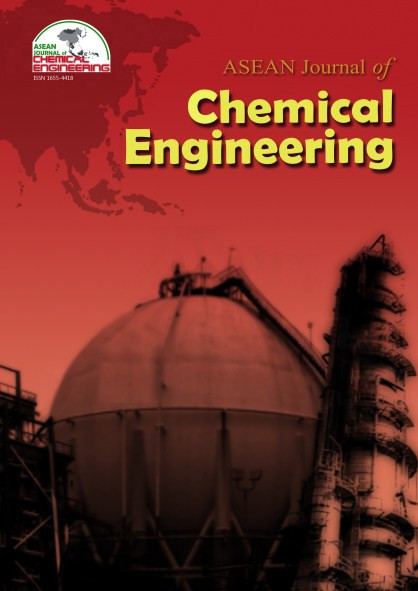Extraction of Flavonoids from Merremia mammosa Using Ethanol Solvent in a Fixed-Bed Column
Abstract
This research aims to investigate the best operating condition for the extraction process of flavonoids from Merremia mammosa root by determining the mass transfer coefficient (Ke). The root was prepared by drying, crushing, and sieving into a homogeneous size and then extracted in a fixed-bed column using 70 wt% of ethanol as a solvent for 2 hours. The obtained samples were then analyzed every 30 min using high-performance liquid chromatography. The parameters investigated in this research were particle size of 1.275, 1.85, and 4.01 mm and solvent flow rate of 3, 6, and 9 mL/s. Based on the experimental data, the value of Ke was calculated using the Hooke-Jeeves numerical method of optimization. The results showed that the decrease in particle size and the increase in solvent flow rate could increase the Ke values, leading to the high concentration of flavonoids extracted using the solvent. The Kevalues obtained in this research ranged from 0.3145 m/s to 0.7880 m/s. The empirical equation that shows the correlation between Ke and the parameters can be expressed as Sh = 1.10 × 1014Re0.0564 (1 − ε)0.8718 with a relative error of 6.13% compared with the experimental data (Sh is the Sherwood number, Re is the Reynolds number, and ε is the porosity of the fixed-bed column).
References
Arunachalam, K., & Parimelazhagan, T. (2012). "Antidiabetic activity of aqueous root extract of Merremia tridentata (L.) Hall. f. in streptozotocin-induced-diabetic rats" Asian Pac. J. Trop. Med., 5(3), 175–179.
Borja, J. Q., Uy, M. M., Lim, J. S., Ong, M. E., & Ros, A. M. (2014). "Microwave – Assisted extraction of chlorogenic acid from Coffee liberica L," ASEAN J. Chem. Engi., 14(2), 58–66.
Hidayat, F. K., Elfiah, U., & Sofiana, K. D. (2015). "Comparison of the number of macrophage in full thickness wound incision between Merremia mammosa extract treatment and NaCl in male wistar rats," Journal of Agromedicine and Medical Science, 1(1), 9–13.
Marchianti, A. C. N., Prameswari, M. C., Sakinah, E. N., & Ulfa, E. U. (2019). "The enhancement of collagen synthesis process on diabetic wound by Merremia mammosa (lour.) extract fraction," Int. J. Pharm. Pharm. Sci., 11(2), 47–50.
Marchianti, A. C. N., Sakinah, E. N., Elfiah, U., Putri, N. K. S., Wahyuliswari, D. I., Maulana, M., & Ulfa, E. U. (2021). "Gel formulations of Merremia mammosa (Lour.) accelerated wound healing of the wound in diabetic rats," J. Tradit. Complement. Med., 11(1), 38–45.
Marchianti, A. C. N., Ulfa, E. U., & Sakinah, E. N. (2018). "The dose dependence analysis of the water fraction of merremia mammosa (lour.) extract on diabetic wound healing enhancement," Hiroshima J. Med. Sci., 67, 29–34.
Mulyono, P., Amarullah, G. M., & Arsadduddin, Z. (2013). "Extraction of levodopa from Mucuna pruriens seed using water in fixed bed column," 8th International Forum on Strategic Technology 2013, IFOST 2013 - Proceedings
Perry, R. H., Green, D. W., & Maloney, J. O. (1997). Chemical engineers’ Handbook (7th ed.). McGraw-Hill.
Putri, N. R. E., Ulfah, A. A., & Kusumastuti, Y. (2019). "Synthesis of curcumin nanoparticle from Curcuma xanthorrhiza Roxb extract by solvent-antisolvent precipitation method," J. Rek. Pros., 13(2), 145–150.
Ratnadewi, A. A. I., Wahyudi, L. D., Rochman, J., Susilowati, Nugraha, A. S., & Siswoyo, T. A. (2018). "Revealing anti-diabetic potency of medicinal plants of Meru Betiri National Park, Jember-Indonesia," Arabi. J. Chem., 13(1), 1831–1836.
Sakinah, E. N., Ulfa, E. U., & Marchianti, A. C. N. (2018). "The effectiveness of merremia mammosa (Lour.) extract fractions as diabetic wound healers on diabetic rat model," Hiroshima J. Med. Scie., 67, 70–77.
Sari, M. D. (2016). "Extraction of flavonoid from Merremia mammosa using ethanol 70% as solvent in fixed bed column," In Research Report, Chemical Engineering Department, Faculty of Engineering, Universitas Gadjah Mada, Indonesia.
Sowndhararajan, K., Joseph, J. M., Arunachalam, K., & Manian, S. (2010). "Evaluation of Merremia tridentata (L.) Hallier f. for in vitro antioxidant activity," Food Scie. Biotechnol., 19(3), 663–669.
Wahjuningsih, S. B., Haslina, & Catur, H. (2019). "Study of temperature variation on physicochemical characteristics of bidara upas tuber (Merremia Mammosa (Lour) Hall. F.) flours," IOP Conference Series: Earth and Environmental Science, 292, 1–6.
Yuzki, A. S. (2016). "Extraction of flavonoid from Merremia mammosa using ethanol as solvent in fixed bed column with the parameter of particle diameter," In Research Report, Chemical Engineering Department, Faculty of Engineering, Universitas Gadjah Mada, Indonesia.
Copyright holder for articles is ASEAN Journal of Chemical Engineering. Articles published in ASEAN J. Chem. Eng. are distributed under a Creative Commons Attribution-NonCommercial 4.0 International (CC BY-NC 4.0) license.
Authors agree to transfer all copyright rights in and to the above work to the ASEAN Journal of Chemical Engineering Editorial Board so that the Editorial Board shall have the right to publish the work for non-profit use in any media or form. In return, authors retain: (1) all proprietary rights other than copyright; (2) re-use of all or part of the above paper in their other work; (3) right to reproduce or authorize others to reproduce the above paper for authors’ personal use or for company use if the source and the journal copyright notice is indicated, and if the reproduction is not made for the purpose of sale.


